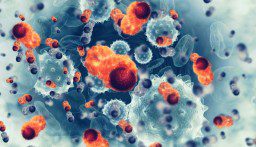ในเดือนกุมภาพันธ์ry 2023, a phase 1 trial at a single institution found that it was safe and possible for people with heavily pretreated large B-cell lymphoma (LBCL) to use CD22-directed chimeric antigen receptor (CAR) T-cell therapy after relapse on CD19-directed การบำบัดด้วย CAR T-cell. In addition, patients exhibited high overall response rates (ORRs), and complete responses (CRs) in these patients were found to be durable.
A presentation by lead study author Matthew J. Frank, MD, PhD, assistant professor of medicine in the Division of Bone Marrow Transplant & Cellular Therapy at the Stanford Cancer Institute, said, “A single infusion of CAR22 produced high response rates in heavily pretreated large B-cell lymphoma patients who relapsed after CAR19.” Frank is the director of the study and an assistant professor of medicine.
CD19 กำกับ การบำบัดด้วย CAR T-cell has led to significant responses in patients with relapsed/refractory LBCL; however, if relapse occurs, patients have a very poor prognosis, and many exhibit CD19 loss or reduced expression.
แฟรงก์กล่าวว่า “มีการบำบัดรักษาไม่เพียงพอหลังจากอาการกำเริบเรื้อรัง” เนื่องจากการพยากรณ์โรคที่ไม่ดีของผู้ป่วยที่กำเริบหลังจากได้รับการบำบัดด้วยคาร์นิทีน จึงมีความต้องการการรักษาแบบใหม่ที่ยังไม่ได้รับการตอบสนองอย่างเร่งด่วน
CD22 is of interest as a target for CAR T-cell therapy as it can be found on the surface of malignant B cells in 95% of B-cell acute lymphoblastic leukaemias (ALLs) and LBCLs. CD22-directed CAR T-cell therapy has already demonstrated high response rates in patients with heavily pretreated ALL.
Adults with B-cell ALL and B-cell มะเร็งต่อมน้ำเหลืองที่ไม่ใช่ประเดี๋ยวประด๋าว were enrolled in the dose-escalation phase 1 study of CAR T-cell therapy directed at CD22. Frank presented at the Tandem Meetings the results of the LBCL cohort.
ผู้ป่วยทุกรายในกลุ่มนี้มี LBCL ที่กำเริบ/ดื้อยา รวมถึง LBCL แบบกระจายที่ไม่ได้ระบุเป็นอย่างอื่น มะเร็งต่อมน้ำเหลืองฟอลลิคูลาร์ที่เปลี่ยนรูป มะเร็งต่อมน้ำเหลืองบริเวณขอบ มะเร็งเม็ดเลือดขาวชนิด lymphocytic/small lymphocytic lymphoma, primary mediastinal B-cell lymphoma, and secondary central nervous system involvement. In addition, patients were resistant to CD19-directed CAR T-cell therapy or had CD19-negative disease in conjunction with any CD22 expression. Patients who had previously received CAR T-cell therapy had to have at least 30 days passed since their last infusion and less than 5% CAR-positive cells in their peripheral blood, according to flow cytometry.
Patients received either 1 x 106 (dose level 1) or 3 x 106 (dose level 2) of the CD22-targeted drug (dose level 2). Prior to infusion, patients received intravenous fludarabine (30 mg/m2) and cyclophosphamide (500 mg) to administer lymphodepleting chemotherapy.
The primary objectives of the study were manufacturing feasibility, the phase 2 dose recommendation, safety, and toxicity. The investigator-assessed ORR, duration of response, progression-free survival (PFS), overall survival (OS), CAR T associated toxicity, CD22 antigen expression, CAR-positive cell levels in the blood, and serum cytokine profiling were secondary endpoints.
จากผู้ป่วยที่ลงทะเบียน 41 ราย ผลิตภัณฑ์ CAR T-cell ประสบความสำเร็จในการผลิต 38 ราย (95%) เนื่องจาก 2 รายมี T-cell ไม่เพียงพอสำหรับภาวะเม็ดเลือดขาว ระยะเวลาเฉลี่ยระหว่าง leukapheresis และ infusion คือ 18 วัน
The median age of participants who received CAR T-cell therapy was 65 (range, 25-84), they had an ECOG performance status of 0 or 1, and they had received a median of 4 prior lines of therapy (range, 3-8). 74% of patients had diffuse LBCL, and 21% had transformed follicular โรคมะเร็งต่อมน้ำเหลือง. 39% of patients were diagnosed with non-germinal centre B-cell-like disease, and 18% had double-hit status. 97% of patients had previously received CD19-directed CAR T-cell therapy, and 18% had previously undergone autologous hematopoietic stem cell transplantation. 29 percent of patients did not achieve a CR to any prior therapy.
เวลาติดตามผลเฉลี่ยสำหรับผู้ป่วยทุกรายคือ 18.4 เดือน (ช่วง: 1.5-38.6) ซึ่ง ORR อยู่ที่ 68% และอัตรา CR อยู่ที่ 53% PFS เฉลี่ยคือ 2.9 เดือน (ช่วงความเชื่อมั่น 95% [CI], 1.7-NR) และค่ามัธยฐาน OS คือ 22.5 เดือน (95% CI, 8.3-NR)
ที่ระดับขนาดยา 1 (n = 29) ผู้ป่วยได้รับการติดตามค่ามัธยฐาน 14.1 เดือน (ช่วง 1.5-38.6) ซึ่งแสดงค่า ORR 66% และอัตรา CR 52% ค่ามัธยฐานของการอยู่รอดโดยปราศจากการลุกลามคือ 3.0 เดือน (95% CI, 1.6-NR) และการรอดชีวิตโดยรวมโดยค่ามัธยฐานคือ NR (95% CI, 8.3-NR)
ที่ระดับขนานยา 2 (n = 9) ค่ามัธยฐานของการติดตามคือ 27.1 เดือน (ช่วง: 24.7-33.5) ORR คือ 78% และอัตรา CR คือ 55% PFS เฉลี่ยคือ 2.6 เดือน (ช่วงความเชื่อมั่น 95%: 1.3-NR) และค่ามัธยฐาน OS คือ 22.5 เดือน (ช่วงความเชื่อมั่น 95%: 5.5-NR)
ผู้ป่วยเพียง 1 ใน 20 รายที่ทำ CR ได้กลับเป็นซ้ำเมื่อตัดข้อมูลออก ซึ่งบ่งชี้ว่า CR มีความทนทาน เมื่อถึงเดือนที่ XNUMX ผู้ป่วยทุกคนที่มีความก้าวหน้าในการรักษาได้ทำเช่นนั้น
ใน 95% ของผู้ป่วย กลุ่มอาการปล่อยไซโตไคน์ was observed, with grade 1 events occurring in 37%, grade 2 in 55%, and grade 3 in 3%. 8% of patients experienced neurologic events of grade 1 severity, while 5% experienced events of grade 2 severity. 18% of patients also reported toxicity resembling ลิมโฟฮิสทิโอไซโตซิสของเม็ดเลือด.
ผู้ป่วยรายหนึ่งที่ขนาดยาระดับ 2 เสียชีวิตด้วยภาวะติดเชื้อในวันที่ 40 และผู้ป่วยหนึ่งรายพัฒนา myelodysplasia/acute myeloid leukemia ที่เกี่ยวข้องกับการรักษาโดยไม่มีหลักฐานว่า LBCL กำเริบ 11 เดือนหลังจากได้รับการรักษาด้วย CD22
กำหนดระดับขนาดยาที่แนะนำสำหรับระยะที่ 2 เป็น 1
ข้อมูลที่เผยแพร่ก่อนหน้านี้ให้รายละเอียดการรักษาผู้ป่วยสามรายแรก
ผู้ป่วยทั้ง 19 รายมีลักษณะที่มีความเสี่ยงสูงและเคยได้รับการรักษาก่อนหน้าอย่างน้อย 19 รายการ ซึ่งรวมถึงการบำบัดด้วยเซลล์ CAR T-cell ที่ควบคุมด้วย CD20 ผู้ป่วยรายหนึ่งเคยได้รับการรักษาด้วยเซลล์ CAR T-cell สองครั้ง โดยครั้งที่สองมีเป้าหมายที่ CD3 และ CD28 ผู้ป่วยทั้งสามรายได้รับ CR โดยผู้ป่วยรายที่ XNUMX ได้รับ CR ในวันที่ XNUMX CRs ถูกเก็บไว้นานกว่าสามปี
แฟรงก์ยังตั้งข้อสังเกตอีกว่า “การแพร่กระจายของ CAR22 นั้นมากกว่าและคงอยู่มากกว่า CAR19 ถึงสิบเท่า”
To learn more about patients who have relapsed after CD19-directed CAR T-cell therapy, a planned multicenter phase 2 trial of this agent is being set up. The trial will likely begin this summer.
อ้างอิง
1. Frank MJ, Sahaf B, Baird J, et al. CD22 CAR T cell therapy induces durable remissions in patients with large B เซลล์มะเร็งต่อมน้ำเหลือง who relapse after CD19 CAR T cell therapy. Presented at: 2023 Transplantation & Cellular Therapy Meetings of ASTCT and CIBMTR; February 15-19, 2023; Orlando, FL. Abstract 2.
2. Baird JH, Frank MJ, Craig J และอื่น ๆ การบำบัดด้วยเซลล์ T-cell CAR ที่กำกับด้วย CD22 ทำให้เกิดการทุเลาอย่างสมบูรณ์ในมะเร็งต่อมน้ำเหลือง B-cell ขนาดใหญ่ที่ดื้อต่อ CAR ที่กำกับด้วย CD19 เลือด. 2021;137(17):2321-2325. doi:10.1182/blood.2020009432


